This was published 6 years ago
Bombardier CSeries: The ultra-comfortable plane that airlines don't think you want
By Hugh Morris
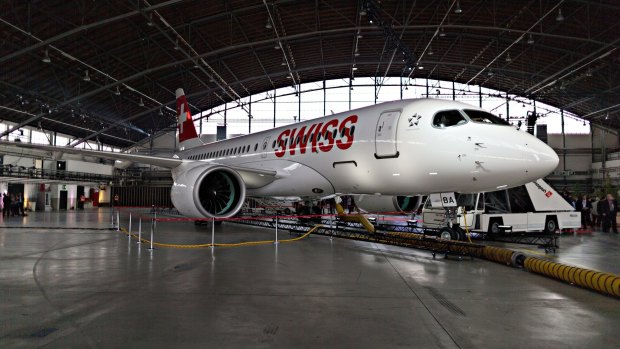
Bombardier CS 100 C Series jet during its delivery to Swiss last year. Only two European carriers fly the CSeries of 100- and 145-passengers planes - Swiss and AirBaltic.Credit: Bloomberg
Bombardier, the aircraft manufacturer at the centre of a dispute which threatens to damage relations between the US and UK, is very proud of its new plane.
The CSeries, introduced to the public last year, promises "unparalleled comfort" in a single-aisle cabin, offering wider seats, bigger overhead compartments and larger windows. It was pioneered for airlines who wanted to give their customers that little bit more, while also enjoying fuel efficiency and reduced noise pollution.
The only problem? Very few airlines are interested.
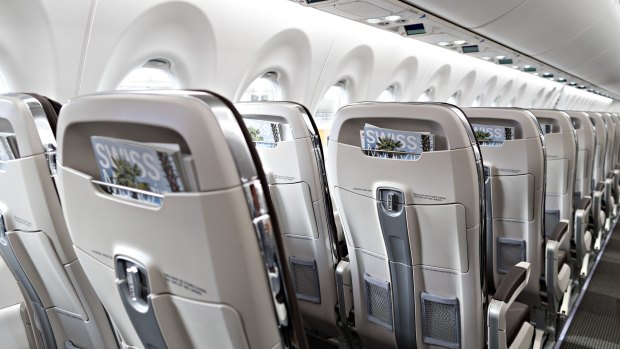
The CSeries, introduced to the public last year, promises "unparalleled comfort" in a single-aisle cabin, offering wider seats, bigger overhead compartments and larger windows.Credit: Bloomberg
Only two European carriers fly the CSeries of 100- and 145-passengers planes - Swiss and AirBaltic, and though they praise the performance of the aircraft and have more on the order books, there is concern that few others will plump to stray from their traditional Boeing and Airbus models in the name of passenger comfort.
Who is Bombardier?
"Bombardier is the world's leading manufacturer of both planes and trains," says the company. That is to say it leads among companies that make both forms of transit - not that it leads in both markets.
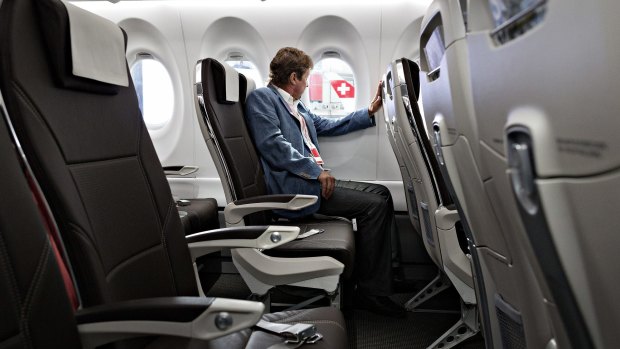
With five seats to a row, rather than six, passengers of the CS100 enjoy seats with 18.5 inch widths (45.7cm) and 30-32 inches (76-81cm) of legroom in economy.Credit: Bloomberg
In fact, when it comes to aircraft it is small fry. The Canadian company's aerospace division had a revenue of $US9.2 billion ($A11.7 billion) in 2016, next to Boeing's $US65 billion and Airbus's $US66.6 billion. Boeing, based in Seattle, and Airbus, in Toulouse, are the two giants of the aviation industry.
However, it has forged a path for itself in the smaller business jet market, with aircraft such as the Learjet, Challenger and Global.
The manufacturer, one of Northern Ireland's biggest employers, has become a pawn in a larger battle between Boeing and Airbus about public subsidies.
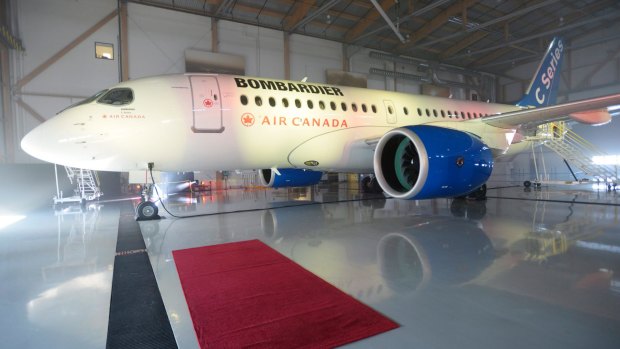
The U.S Commerce Department slapped duties of nearly 220 per cent on Canada's Bombardier C Series last month.Credit: AP
What's so good about the CSeries?
The fundamental difference is that with five seats to a row, rather than six, passengers (of the CS100) enjoy seats with 18.5 inch widths (45.7cm) and 30-32 inches (76-81cm) of legroom in economy; compared to say, Qantas' Boeing 737 layout, which allows for 17-inch widths and 30 inches of legroom.
AirBaltic, the first airline in the world to fly the CS300 (the CS100's larger sister), with seven of an order of 20 currently in its possession, said the plane has "performed beyond the company's expectations, delivering better overall performance, fuel efficiency and convenience for both staff and the passengers".
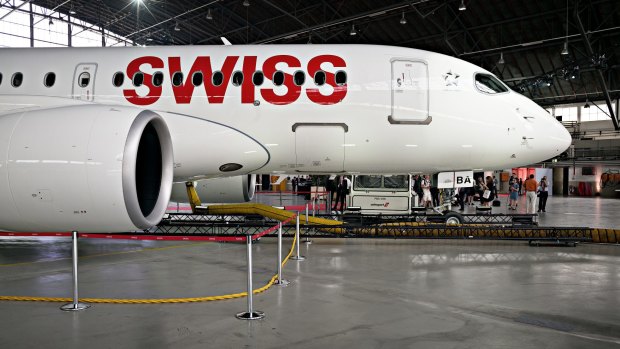
The Canadian company's aerospace division had a revenue of $US9.2 billion ($A11.7 billion) in 2016, next to Boeing's $US65 billion and Airbus's $US66.6 billion. Credit: Bloomberg
In a statement, the airline, which operates out of Riga, Latvia, flying to 68 destinations, said: "The new CS300 aircraft with 145 seats, offers excellent flying experience with benefits for passengers, such as wider seats, larger windows, more hand luggage space in the cabin, and improved lavatories."
Why is nobody buying it?
Word on the market is that airlines want bigger planes that fly more passengers, earning them more revenue and enabling them to keep fares down.
"Passengers get into anything that flies if the ticket is cheap," AirBaltic chief executive Martin Gauss told the Wall Street Journal.
Despite concerns that Bombardier's order list (about 350) pales in comparison to the likes of Boeing (more than 3800) and Airbus (more than 5100), the manufacturer was upbeat in a recent assessment of its 20-year forecast.
"The outlook for our markets is strong," said president Fred Cromer. "We are the only manufacturer with a solution for any type of business model in the 60- to 150-seat segment, and we are well positioned to capture the value from the exciting opportunities outlined in this market forecast."
But analysts say that the Bombardier's pricing of the CSeries was too high for airlines to consider it as a single-aisle alternative.
What is the new dispute about?
The US is poised to impose punitive tariffs on Bombardier after the company lost the first round of an international trade dispute with Boeing.
Boeing's battle over Bombardier is indirectly related to its long-running feud with Airbus. The pair are the biggest aircraft makers in the world: one American, the other European, headquartered in France.
As it has rumbled on, the dispute is now being fought for them by proxy between the European and US governments.
With regards to Bombardier, Boeing claims the Canadian company received illegal support for its C-series small airliner when the province of Quebec took a $US1 billion stake in the troubled programme. This support ultimately helped Bombardier agree a sale of up to 125 of airliners to US carrier Delta at big discount.
So sensitive is the row - with the fate of 4500 jobs in Northern Ireland on the line - that Theresa May asked Donald Trump to intervene earlier this month. Awkwardly, Boeing has reminded the prime minister that it employs 16,500 people in its supply chain in the UK.
One of the most interesting things about the case is that Boeing hasn't really seen sales snatched away by Delta's purchase of the C-Series. The Bombardier jet is smaller than Boeing's smallest craft, the 737; essentially they are targeting different markets.
So how does Boeing's sabre-rattling over Bombardier relate to Airbus? Well, the US giant doesn't want to see another potential competitor supported in the same way that has allowed Airbus to come from nothing in the Seventies to being an equal rival today.
In fact, both sides claim the other has benefited from state aid at some point - given the high cost of producing aircraft, state subsidies have been an inevitable part of the aerospace sector for a long time. Unsurprisingly, some have accused Boeing of hypocrisy in taking on Bombardier, a much smaller rival, over the issue.
Where does this leave Bombardier? The company is already looking ahead to a ruling next year from the International Trade Commission on whether Boeing suffered any injury from the C Series. It is confident in its case: "Because Boeing years ago abandoned the market the C Series serves, there is no harm," it says. This battle has much further to run. - Alan Tovey & Jon Yeomans.
The Telegraph, London
See also: The A380 superjumbo is 10 - how has it measured up?
See also: Cheap fares, better planes - why are airline passengers still whingeing?
Sign up for the Traveller newsletter
The latest travel news, tips and inspiration delivered to your inbox. Sign up now.